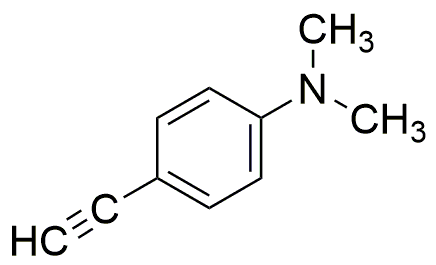4-Ethynyl-N,N-dimethylaniline is widely utilized in research focused on:
- Organic Synthesis: This compound serves as a versatile building block in the synthesis of various organic molecules, particularly in the development of dyes and pigments.
- Polymer Chemistry: It is used in the production of specialty polymers, enhancing properties such as thermal stability and chemical resistance, making it valuable in the plastics industry.
- Pharmaceutical Development: The compound plays a role in the synthesis of pharmaceutical intermediates, contributing to the creation of new medications and therapeutic agents.
- Material Science: It is applied in the formulation of advanced materials, including conductive polymers, which are essential in electronics and energy storage applications.
- Research and Development: This chemical is frequently employed in academic and industrial research settings to explore new chemical reactions and develop innovative applications.
Informations générales
Propriétés
Sécurité et réglementation
Applications
4-Ethynyl-N,N-dimethylaniline is widely utilized in research focused on:
- Organic Synthesis: This compound serves as a versatile building block in the synthesis of various organic molecules, particularly in the development of dyes and pigments.
- Polymer Chemistry: It is used in the production of specialty polymers, enhancing properties such as thermal stability and chemical resistance, making it valuable in the plastics industry.
- Pharmaceutical Development: The compound plays a role in the synthesis of pharmaceutical intermediates, contributing to the creation of new medications and therapeutic agents.
- Material Science: It is applied in the formulation of advanced materials, including conductive polymers, which are essential in electronics and energy storage applications.
- Research and Development: This chemical is frequently employed in academic and industrial research settings to explore new chemical reactions and develop innovative applications.
Documents
Fiches de données de sécurité (FDS)
La FDS fournit des informations de sécurité complètes sur la manipulation, le stockage et l’élimination du produit.
Spécifications du produit (PS)
Le PS fournit une description complète des propriétés du produit, notamment sa composition chimique, son état physique, sa pureté et les exigences de stockage. Il détaille également les plages de qualité acceptables et les applications prévues du produit.
Certificats d'analyse (COA)
Recherchez des certificats d'analyse (COA) en saisissant le numéro de lot du produit. Les numéros de lot et de lot se trouvent sur l'étiquette d'un produit, après les mots « Lot » ou « Lot de fabrication ».
Numéro de catalogue
Numéro de lot/série
Certificats d'origine (COO)
Ce certificat d'exploitation confirme le pays dans lequel le produit a été fabriqué, et détaille également les matériaux et composants utilisés et s'il est issu de sources naturelles, synthétiques ou autres sources spécifiques. Ce certificat peut être requis pour les douanes, le commerce et la conformité réglementaire.
Numéro de catalogue
Numéro de lot/série
Fiches de données de sécurité (FDS)
La FDS fournit des informations de sécurité complètes sur la manipulation, le stockage et l’élimination du produit.
DownloadSpécifications du produit (PS)
Le PS fournit une description complète des propriétés du produit, notamment sa composition chimique, son état physique, sa pureté et les exigences de stockage. Il détaille également les plages de qualité acceptables et les applications prévues du produit.
DownloadCertificats d'analyse (COA)
Recherchez des certificats d'analyse (COA) en saisissant le numéro de lot du produit. Les numéros de lot et de lot se trouvent sur l'étiquette d'un produit, après les mots « Lot » ou « Lot de fabrication ».
Numéro de catalogue
Numéro de lot/série
Certificats d'origine (COO)
Ce certificat d'exploitation confirme le pays dans lequel le produit a été fabriqué, et détaille également les matériaux et composants utilisés et s'il est issu de sources naturelles, synthétiques ou autres sources spécifiques. Ce certificat peut être requis pour les douanes, le commerce et la conformité réglementaire.


